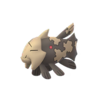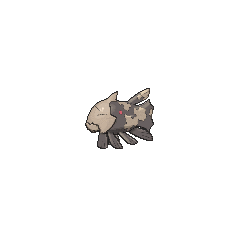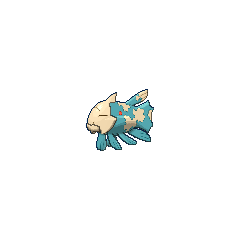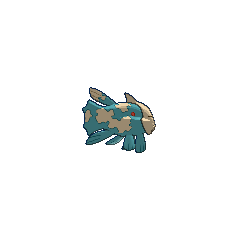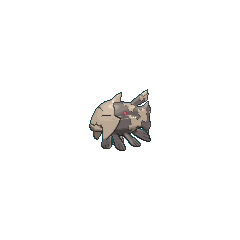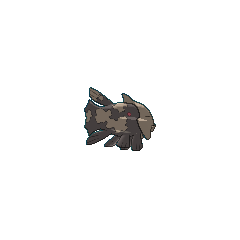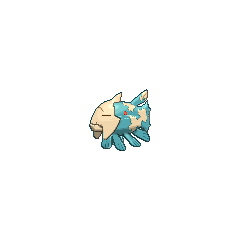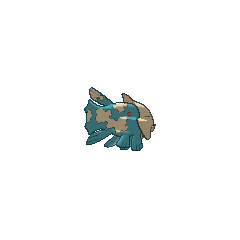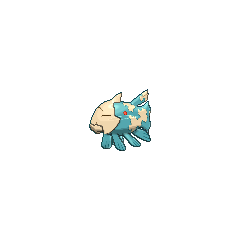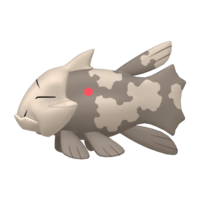Relicanth (Japanese: ジーランス Glanth) is a dual-type Water/Rock Pokémon introduced in Generation III.
It is not known to evolve into or from any other Pokémon.
Biology
Relicanth is a Pokémon that is heavily based on the coelacanth. It is covered with hard, brown scales that are similar to craggy rocks. Its tan head has protruding cheekbones, which are smaller on a female. A triangular spike protrudes from the back of its head. Tan patches cover its body and there is a red spot located on both sides. It possesses two pairs of pectoral fins, which it uses to push itself along the sea bottom. Additionally, it has dorsal and pelvic fins near its tail. Its tail fin has a wavy outline.
The composition of its scales, along with its fatty body and oil-filled swim bladders, allow it to withstand the intense pressure of the ocean depths. Relicanth once had teeth, but they have long since atrophied; as such, Relicanth is a filter feeder, feeding on microscopic organisms that it sucks up with its toothless mouth. It has remained unchanged for 100 million years and stays as such because it is already a perfect life-form. It was discovered during a deep-sea expedition. Relicanth's name comes from an explorer whose name served as a variation of it.
In the anime
Main series
Major appearances
Multiple Relicanth debuted in A Ruin With a View!, where Ash, May, and Professor Alden discovered a lake full of them.
In The Relicanth Really Can!, multiple Relicanth led Adam and Evelyn to treasure.
Minor appearances
A Relicanth appeared in the opening sequence of Lucario and the Mystery of Mew.
In Pokémon Ranger and the Temple of the Sea, multiple Relicanth were present during the final showdown with The Phantom and his crew.
In a flashback in Mutiny in the Bounty!, a Relicanth was one of J's bounties.
In Up Close and Personable!, a Relicanth was living in the lake near the Pokémon Summer Academy.
A Relicanth appeared in the opening sequence of Zoroark: Master of Illusions.
In Going for the Gold!, multiple Relicanth were living in the Ambrette Aquarium.
A Relicanth appeared in Alola to New Adventure!.
A Relicanth appeared in a fantasy in Yo, Ho, Ho! Go, Popplio!.
In That's Some Spicy Island Research!, a Relicanth played with Ash and his classmates' Pokémon at Seafolk Village.
A Relicanth appeared in Pikachu's Exciting Adventure!.
A Relicanth appeared in Looking Out for Number Two!.
Pokédex entries
| Episode
|
Pokémon
|
Source
|
Entry
|
| AG094
|
Relicanth
|
Ash's Pokédex
|
Relicanth, the Longevity Pokémon. Relicanth is covered in stone-like scales, which allow it to withstand the pressure of the deep ocean.
|
|
Pokémon Generations
In The Cavern, two wild Relicanth were in the waters that surrounded the Seafloor Cavern.
In the manga
Pokémon Adventures
Sapphire has a Relicanth nicknamed Relly. He was one of the keys to solving the mystery of the Sealed Chamber. While he still belongs to Sapphire, he was not seen in her party during the Emerald arc and is assumed to be at sea with her Wailord, Lorry, as of Sapphire's latest appearance. He first appeared in The Beginning of the End with Kyogre & Groudon III.
A Relicanth appeared in a fantasy in Pinsir Me, I Must Be Dreaming.
Pokédex entries
| Manga
|
Chapter
|
Entry
|
| Pokémon Adventures
|
PS236
|
This species lives at the bottom of the sea for thousands of years. It only feeds on microorganisms.
|
|
In the TCG
- Main article: Relicanth (TCG)
Game data
Pokédex entries
| This Pokémon was unavailable prior to Generation III.
|
| Generation III
|
|
Hoenn
#179
|
|
Kanto
#—
|
| Ruby
|
Relicanth is a Pokémon species that existed for a hundred million years without ever changing its form. This ancient Pokémon feeds on microscopic organisms with its toothless mouth.
|
| Sapphire
|
Relicanth is a rare species that was discovered in deep-sea explorations. This Pokémon's body withstands the enormous water pressure of the ocean depths. Its body is covered in tough scales that are like craggy rocks.
|
| Emerald
|
A Pokémon that was once believed to have been extinct. The species has not changed its form for 100 million years. It walks on the seafloor using its pectoral fins.
|
| FireRed
|
It has remained unchanged for 100 million years. It was discovered during a deep-sea exploration.
|
| LeafGreen
|
|
|
| Generation IV
|
|
Sinnoh
#—
|
|
Johto
#—
|
| Diamond
|
A rare Pokémon discovered during a deep-sea exploration. It has not changed in over 100 million years.
|
| Pearl
|
| Platinum
|
| HeartGold
|
Discovered by chance during deep-sea explorations, it has not changed since ancient times.
|
| SoulSilver
|
|
|
| Generation V
|
|
|
Unova
#—
|
| Black
|
A rare Pokémon discovered during a deep-sea exploration. It has not changed in over 100 million years.
|
| White
|
| Black 2
|
A rare Pokémon discovered during a deep-sea exploration. It has not changed in over 100 million years.
|
| White 2
|
|
|
| Generation VI
|
|
Kalos
Coastal #042
|
|
Hoenn
#188
|
| X
|
It has remained unchanged for 100 million years. It was discovered during a deep-sea exploration.
|
| Y
|
A rare Pokémon discovered during a deep-sea exploration. It has not changed in over 100 million years.
|
| Omega Ruby
|
Relicanth is a Pokémon species that existed for a hundred million years without ever changing its form. This ancient Pokémon feeds on microscopic organisms with its toothless mouth.
|
| Alpha Sapphire
|
Relicanth is a rare species that was discovered in deep-sea explorations. This Pokémon's body withstands the enormous water pressure of the ocean depths. Its body is covered in tough scales that are like craggy rocks.
|
|
|
| Generation VII
|
|
Alola
SM: #262
|
|
Alola
USUM: #343
|
|
Kanto
#—
|
| This Pokémon has no Pokédex entries in Let's Go, Pikachu! and Let's Go, Eevee!.
|
| Sun
|
Its form has remained the same for one hundred million years. Its body is filled with fat, so it can withstand the water pressure of the deep sea.
|
| Moon
|
It was fortuitously discovered during a deep sea expedition. Its teeth have atrophied, so it now survives on microscopic organisms it sucks up.
|
| Ultra Sun
|
Thought to have gone extinct, Relicanth was given a name that is a variation of the name of the person who discovered it.
|
| Ultra Moon
|
The reason it hasn't changed at all in a hundred million years is that it's apparently already a perfect life-form.
|
|
|
| Generation VIII
|
|
Galar
Crown Tundra #187
|
|
Sinnoh
#—
|
|
Hisui
#—
|
| This Pokémon has no Pokédex entries in Legends: Arceus.
|
| Sword
|
Rock-hard scales and oil-filled swim bladders allow this Pokémon to survive the intense water pressure of the deep sea.
|
| Shield
|
This Pokémon was discovered during deep-sea exploration. Its appearance hasn't changed in 100,000,000 years, so it's called a living fossil.
|
| Brilliant Diamond
|
This rare Pokémon was discovered during a deep-sea exploration. It has not changed in over 100 million years.
|
| Shining Pearl
|
|
|
|
|
Game locations
| This Pokémon was unavailable prior to Generation III.
|
|
|
|
|
|
|
|
|
|
|
|
|
|
|
In side games
| This Pokémon was unavailable prior to Generation III.
|
|
|
|
|
|
|
|
|
|
|
|
|
Held items
Stats
Base stats
| Stat
|
Range
|
| At Lv. 50
|
At Lv. 100
|
100
|
|
160 - 207
|
310 - 404
|
90
|
|
85 - 156
|
166 - 306
|
130
|
|
121 - 200
|
238 - 394
|
45
|
|
45 - 106
|
85 - 207
|
65
|
|
63 - 128
|
121 - 251
|
55
|
|
54 - 117
|
103 - 229
|
Total: 485
|
Other Pokémon with this total
|
- Minimum stats are calculated with 0 EVs, IVs of 0, and (if applicable) a hindering nature.
- Maximum stats are calculated with 252 EVs, IVs of 31, and (if applicable) a helpful nature.
|
Pokéathlon stats
Type effectiveness
| Under normal battle conditions in Generation IX, this Pokémon is:
|
|
|
|
|
|
|
|
|
|
|
|
|
Learnset
|
|
This Pokémon is unavailable within Generation IX.
Click on the generation numbers above to see Relicanth's learnsets from other generations.
|
Side game data
|
|
|
|
|
|
|
|
|
|
|
Pokémon Rumble Rush

|
Walking Speed: 2.45 seconds
|
Base HP: 59
|
|
| Base Attack: 78
|
Base Defense: 59
|
Base Speed: 60
|
|
|
|
|
|
|
|
|
Evolution data
Sprites
| This Pokémon was unavailable prior to Generation III.
|
|
|
|
|
|
|
|
|
|
|
|
|
| This Pokémon is unavailable in Generation IX.
|
|
|
Trivia
Origin
Bulbanews has an article related to this subject:
Relicanth appears to be based on the coelacanth, an order of fish that was thought to have gone extinct around 66 million years ago until their rediscovery in 1938. They are considered living fossils because they appear virtually unchanged from their prehistoric relatives; this is reflected in Relicanth's Rock typing (characteristic of actual Fossil Pokémon) and "elderly" appearance. Relicanth matches the Indonesian coelacanth in color, but its Shiny coloration is like that of the more well-known West Indian Ocean coelacanth. The irregular shapes on Relicanth's brown body with big red spot might be inspired by old treasure maps.
Relicanth's Pokédex entry in Pokémon Ultra Sun may reference the fact that the coelacanth genus, Latimeria, is named after Marjorie Courtenay-Latimer, the discoverer of the first modern coelacanth specimen. Relicanth may also take inspiration from placoderms, an extinct class of fish with armored heads.
Name origin
Relicanth may be a combination of relic (something old that has survived the passage of time), relict and coelacanth.
Glanth may be a combination of 爺 jī (old man) and coelacanth.
In other languages
| Language
|
Title
|
Meaning
|
 Japanese Japanese
|
ジーランス Glanth
|
From 爺 jī and coelacanth
|
 French French
|
Relicanth
|
Same as English name
|
 Spanish Spanish
|
Relicanth
|
Same as English name
|
 German German
|
Relicanth
|
Same as English name
|
 Italian Italian
|
Relicanth
|
Same as English name
|
 Korean Korean
|
시라칸 Searakan
|
From 실러캔스 coelacanth
|
 Mandarin Chinese Mandarin Chinese
|
古空棘魚 / 古空棘鱼 Gǔkōngjíyú
|
From 古 gǔ and 腔棘魚 / 腔棘鱼 qiāngjíyú
|
 Cantonese Chinese Cantonese Chinese
|
古空棘魚 Gúhūnggīk'yùh
|
From 古 gú and 腔棘魚 hōnggīk'yùh
|
|
|
|
| More languages
|
 Hindi Hindi
|
रेलीकंथ Relicanth
|
Transcription of English name
|
 Brazilian Portuguese Brazilian Portuguese
|
Relicário
|
From relicário
|
 Russian Russian
|
Реликант Relikant
|
Transcription of English name
|
 Thai Thai
|
จีแลนซ์ Chilaen
|
Transcription of Japanese name
|
|
|
|
External links

|
This Pokémon article is part of Project Pokédex, a Bulbapedia project that aims to write comprehensive articles on each Pokémon species, as well as Pokémon groups and forms.
|
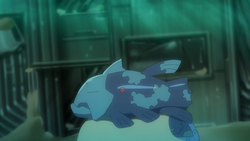


 For other sprites and images, please see Relicanth images on the Bulbagarden Archives.
For other sprites and images, please see Relicanth images on the Bulbagarden Archives.




